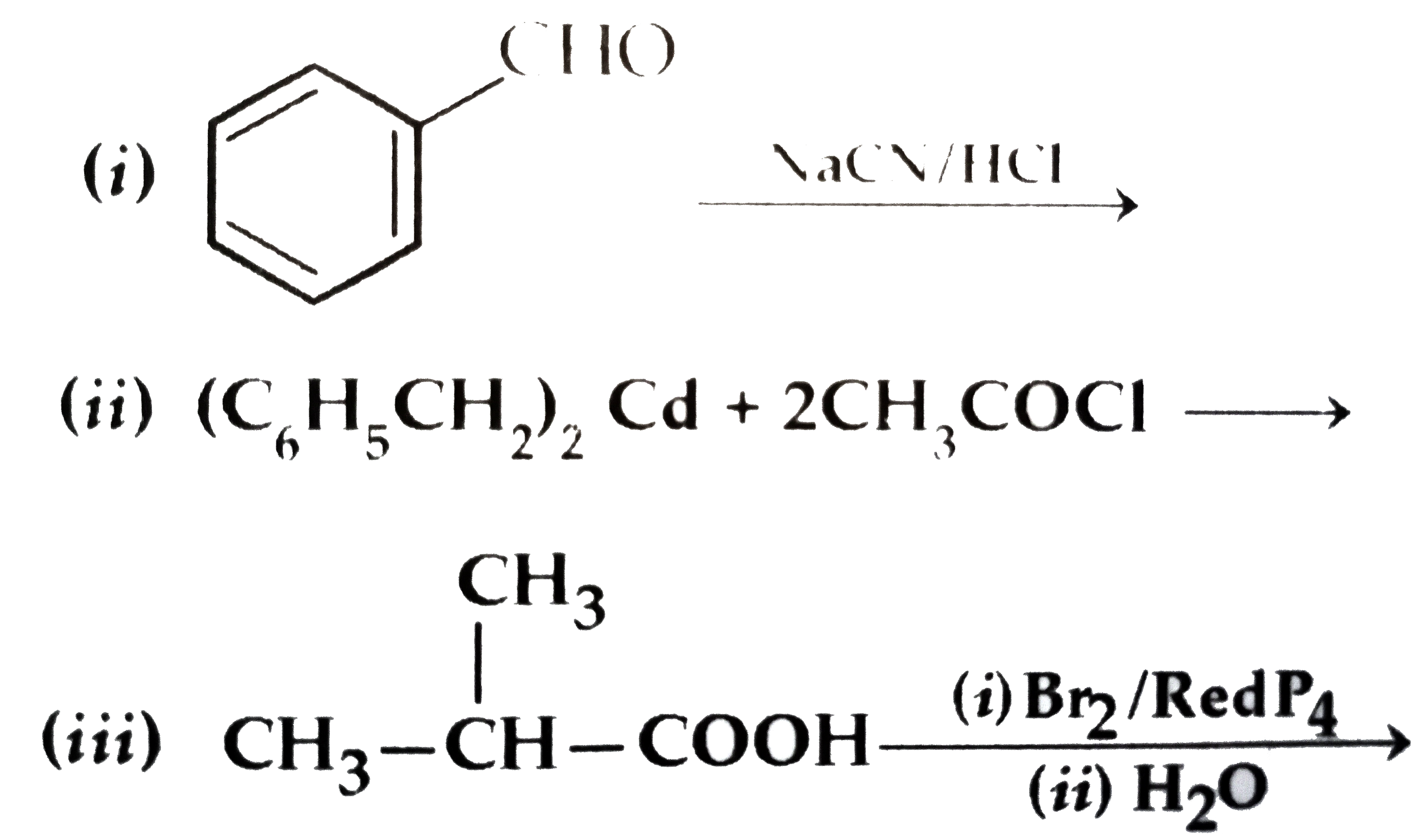Complete the following reactions:
(i) C2H5I+H2Zn−Cu−−−−→C2H5OHK
(ii) CH30COONa+H2OElectrolysis−−−−−−−→Y
(iii) CH3CH2CH2CH2CH2CH3Cr2O3/Al2O3−−−−−−−−→773KZ
X=C2H6,Y=C2H6,Z=C6H6
X=CH4,Y=CH30COOH,Z=CH3CH3
X=C2H6,Y=CH4,Z=C4H10
X=C2H6,Y=CH4,Z=C5H10
The correct Answer is:A
Let's solve the reactions step by step.
Reaction (i):
Given Reaction:
C2H5I+H2Zn−Cu−−−−→X
Step 1: Identify the reactants.
- The reactant is iodoethane (C2H5I) and hydrogen gas (H2).
Step 2: Determine the type of reaction.
- This is a reduction reaction where the iodine atom in iodoethane will be replaced by hydrogen.
Step 3: Write the balanced equation.
- The reaction will eliminate hydrogen iodide (HI) and form ethane (C2H6).
Final Product:
X=C2H6 (Ethane)
Reaction (ii):
Given Reaction:
CH3COONa+H2OElectrolysis−−−−−−−→Y
Step 1: Identify the reactants.
- The reactant is sodium acetate (CH3COONa) and water (H2O).
Step 2: Determine the type of reaction.
- This is an electrolysis reaction, which will lead to decarboxylation.
Step 3: Write the balanced equation.
- During electrolysis, sodium acetate will lose a carbon dioxide molecule (CO2) and form ethane (C2H6).
Final Product:
Y=C2H6 (Ethane)
Reaction (iii):
Given Reaction:
CH3CH2CH2CH2CH2CH3773K,Cr2O3//Al2O3−−−−−−−−−−−−→Z
Step 1: Identify the reactants.
- The reactant is n-hexane (C6H14).
Step 2: Determine the type of reaction.
- This is a dehydrogenation reaction that occurs at high temperatures, leading to cyclization and aromatization.
Step 3: Write the balanced equation.
- The n-hexane will undergo dehydrogenation and cyclization to form benzene (C6H6).
Final Product:
Z=C6H6 (Benzene)
Summary of Products:
- X=C2H6 (Ethane)
- Y=C2H6 (Ethane)
- Z=C6H6 (Benzene)
---
Given Reaction:
C2H5I+H2Zn−Cu−−−−→X
- The reactant is iodoethane (C2H5I) and hydrogen gas (H2).
- This is a reduction reaction where the iodine atom in iodoethane will be replaced by hydrogen.
- The reaction will eliminate hydrogen iodide (HI) and form ethane (C2H6).
Final Product:
X=C2H6 (Ethane)
Given Reaction:
CH3COONa+H2OElectrolysis−−−−−−−→Y
- The reactant is sodium acetate (CH3COONa) and water (H2O).
- This is an electrolysis reaction, which will lead to decarboxylation.
- During electrolysis, sodium acetate will lose a carbon dioxide molecule (CO2) and form ethane (C2H6).
Final Product:
Y=C2H6 (Ethane)
Given Reaction:
CH3CH2CH2CH2CH2CH3773K,Cr2O3//Al2O3−−−−−−−−−−−−→Z
- The reactant is n-hexane (C6H14).
- This is a dehydrogenation reaction that occurs at high temperatures, leading to cyclization and aromatization.
- The n-hexane will undergo dehydrogenation and cyclization to form benzene (C6H6).
Final Product:
Z=C6H6 (Benzene)
- X=C2H6 (Ethane)
- Y=C2H6 (Ethane)
- Z=C6H6 (Benzene)
Topper's Solved these Questions
- HYDROCARBONS BOOK - NCERT FINGERTPS ENGLISHCHAPTER - HYDROCARBONS EXERCISE - Higher Order Thinkin Skills
7 Videos
- HYDROCARBONS BOOK - NCERT FINGERTPS ENGLISHCHAPTER - HYDROCARBONS EXERCISE - Assertion & Reason
15 Videos
- EQUILIBRIUM BOOK - NCERT FINGERTPS ENGLISHCHAPTER - EQUILIBRIUM EXERCISE - Assertion And Reason
15 Videos
- HYDROGEN BOOK - NCERT FINGERTPS ENGLISHCHAPTER - HYDROGEN EXERCISE - Assertion And Reason
15 Videos
Similar Questions
Knowledge Check
Which of the following combinations give C6H5−CH3∣C∣CH2CH3−OH?
APhMgBr and H3C−O∣∣C−CH2CH3BCH3MgBrandPh−O∣∣C−CH2CH3CCH3MgBrandC6H5−O∣∣C−OC2H5DCH3CH2MBrandPh−O∣∣C−CH3
CH3−CH2−CH2−O−CH3 and CH3−CH3∣CH−O−CH3 are
View SolutionThe product "A" in the following reaction is :CH3−CO−CH2COOC2H5NaOH−−−−−−→H2OA
View SolutionComplete the following reactions
(i) CH3−O∣∣C−CH3CH3MgBr−−−−−→ether(dry)AH3O+−−−→B (ii) CH3−CH2−CH2−CHONi/H2−−−→A
View SolutionComplete the following reactions:
(i)
(ii) (C6H5CH2)2Cd+2CH3COC<o
(iii) CH3−CH3∣CH−COOH(i)Br2/RedP4−−−−−−−−−→(ii)H2O
View SolutionWrite the IUPAC names of the following compounds
(i) CH3−CH2−O∣∣C−CH2−O∣∣C−CH3
(ii) CH3−O∣∣C−CH2−CH2−CH2−CH2−COOH
(iii) CH3−CH∣C2H5−CH∣C2H5−CH3
View SolutionGiven the IUPAC names of the following compounds:
(i) CH3CH2CH2CH3C∣∣C2H5CH2−CH3∣C=CH2
(ii) CH3−CH3CH−C≡CH
(iii) C6H5−CH=CH−CH2Cl
CH3CH−CH−CH2Cl
(iv) CH3CH=CH−CH2Br
v CH2=CH−Cl∣C−CH=CH2
vi CH2=CH−CH2CH3C∣H−C∣Cl=CH2
vii. (CH3)3C−CH=CH2
View SolutionConsider the following reactions
I.
II.(CH3)2C∣OH−CH2−CHOΔ−−→
III. (CH3)2CHCH2−C∣FH−CH3CH3O−Na+−−−−−−−−−−→Δ
IV. (CH3)2CH−C∣BrH−CH3(CH3)3CO−k+−−−−−−−−−−→
Which of these reaction will not produce Hoffmann product?
View Solution

